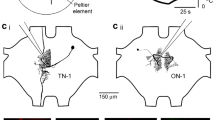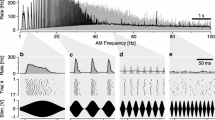Summary
-
1.
The responses of fifty-eight neurons in the cricket brain to auditory stimuli were studied by intracellular recording, after which the cells were marked with Lucifer Yellow. These auditory interneurons could be assigned to three classes on the basis of anatomical criteria: (i) neurons (AN1 and AN2) ascending from the prothoracic ganglion into the brain, (ii) brain neurons (BNC 1) with arborizations overlapping those of ascending cells, and (iii) brain neurons (BNC 2) with arborizations that had no overlap with those of ascending cells.
-
2.
All the ascending neurons had one projection field in common, an area in the anterior dorsal region of the diffuse neuropil lateral to the alphalobe. This field overlaps one of the projection fields of the BNC 1 neurons. Other projection fields of the BNC 1 neurons are frequently found in the posterior ventral region, at the boundary between the proto and deutocerebrum; the latter overlap projection fields of the BNC 2 cells, the arborizations of which are often not clearly distributed in more than one distinct region (Figs. 1–4).
-
3.
The threshold curves and suprathreshold responses revealed that all three classes (AN, BNC 1 and BNC 2) include cells with low frequency (5 kHz) and others with broad-band (2–20 kHz) tuning; high-frequency (10–20 kHz) tuning was found only in AN and BNC 1 cells. Within the region to which the cells were tuned, sensitivity decreased in the order AN, BNC 1, BNC 2 (Figs. 2–4). A frequently observed property of BNC 2 neurons was independence of sound intensity in the suprathreshold intensity region. The response latency increased in the order AN, BNC 1, BNC 2 (Figs. 5, 6).
-
4.
The effect of stimulus temporal structure was studied by presenting ‘constant-energy-chirps’, trains of sound pulses (syllables) varying in duration and repetition interval. The low frequency AN1 neurons, like other prothoracic neurons, copy such signals over a broad range of repetition intervals. Copying by the BNC 1 neurons was less accurate, and the responses of BNC 2 neurons were often not detectably synchronized with the syllables of the stimuli (Figs. 7–10).
-
5.
Strikingly, the magnitude of the BNC 2 responses was in some cases (7 out of 15) found to vary with repetition interval; curves for the BNC 2 responses vs. repetition interval match closely those for the behavioral tracking response of females given an identical stimulus paradigm, and are independent of intensity at intensities 10 dB or more above threshold. By contrast, the responses of AN and most BNC 1 neurons are uniform, regardless of stimulus intensity, over the entire range of repetition intervals studied (Fig. 11).
-
6.
Some BNC 2 neurons responded to constantenergy chirps only with short and intermediate or with intermediate and long repetition intervals, resembling the high-pass and low-pass neurons found in frogs (Fig. 12). This finding, the systematic latency differences, and the anatomical relationships among the AN, BNC 1 and BNC 2 cells all point to a rather specific picture of the way that the male calling song is recognized.
Similar content being viewed by others
Abbreviations
- AN :
-
Ascending neuron
- BNC1 :
-
Brain neuron class 1
- BNC2 :
-
Brain neuron class 2
- BP :
-
Band-pass
- HF :
-
Highfrequency
- HP :
-
High-pass
- LCT :
-
Latency corrected timing
- LF :
-
Low-frequency
- LP :
-
Low-pass
- SC :
-
Synchronization coefficient
- SRI :
-
Syllable repetition interval
References
Boyan GS (1980) Auditory neurones in the brain of the cricketGryllus bimaculatus (De Geer). J Comp Physiol 140:81–93
Boyan GS (1981) Tow-tone suppression of an identified auditory neurone in the brain of the cricketGryllus bimaculatus (De Geer). J Comp Physiol 144:117–125)
Boyan GS (1983) Postembryonic development in the auditory system of the locust. J Comp Physiol 151:499–513
Boyan GS, Williams JLD (1981) Descending interneurones in the brain of the cricket. Naturwissenschaften 67:486
Boyan GS, Williams JLD (1982) Auditory neurones in the brain of the cricketGryllus bimaculatus (De Geer): Ascending interneurones. J Insect Physiol 28:493–501
Boyd P, Kühne R, Silver S, Lewis B (1984) Two-tone suppression and song coding by ascending neurons in the cricketGryllus campestris L. J Comp Physiol A 154:423–430
Capranica RR, Rose G (1983) Frequency and temporal processing in the auditory system of anurans. In: Huber F, Markl H (eds) Neuroethology and behavioral physiology. Springer, Berlin Heidelberg New York Tokyo, pp 136–152
Casaday GB, Hoy RR (1977) Auditory interneurons in the cricketTeleogryllus oceanicus: Physiological and anatomical properties. J Comp Physiol 121:1–13
Eichendorf A, Kalmring K (1980) Projections of the auditory ventral-cord neurons in the supraesophageal ganglion ofLocusta migratoria. Zoomorphologie 94:133–149
Esch H, Huber F, Wohlers DW (1980) Primary auditory neurons in crickets; Physiology and central projections. J Comp Physiol 137:27–38
Hutchings M, Lewis B (1981) Response properties of primary auditory fibers in the cricketTeleogryllus oceanicus (Le Guillou). J Comp Physiol 143:129–134
Kleindienst HU, Koch UT, Wohlers DW (1981) Analysis of the cricket auditory system by acoustic stimulation using a closed sound field. J Comp Physiol 141:283–296
Moiseff A, Hoy R (1983) Sensitivity to ultrasound in an identified auditory interneuron in the cricket: Possible neural link to phonotactic behaviour. J Comp Physiol 152:155–167
Nocke H (1972) Physiological aspects of sound communication in crickets (Gryllus campestris L.). J Comp Physiol 80:141–162
Pollack GS, Hoy R (1979) Temporal pattern as a cue for speciesspecific calling song recognition in crickets. Science 204:429–432
Pollack GS, Huber F, Weber T (1984) Frequency and temporal pattern dependent phonotaxis of crickets (Teleogryllus oceanicus) during tethered flight and compensated walking. J Comp Physiol 154 A: 13–26
Popov AV, Markovich AM (1982) Auditory interneurons in the prothoracic ganglion of the cricket,Gryllus bimaculatus. J Comp Physiol 146:351–359
Popov AV, Shuvalov VF (1977) Phonotactic behaviour in crickets. J Comp Physiol 119:111–126
Popov AV, Markovich AM, Andjan AS (1978) Auditory interneurons in the prothoracic ganglion of the cricket,Gryllus bimaculatus DeGeer. J Comp Physiol 126:183–192
Rheinlaender J, Kalmring K, Popov AV, Rehbein H (1976) Brain projections and information processing of biologically significant sounds by two large ventral-cord neuronsof Gryllus bimaculatus De Geer (Orthoptera, Gryllidae). J Comp Physiol 110:251–269
Rose G, Capranica RR (1984) Processing amplitude modulated sounds by the auditory midbrain of two species of toads: matched temporal filters. J Comp Physiol 154 A:211–219
Schildberger K (1982) Untersuchung zur Struktur und Funktion von Interneuronen im Pilzkörperbereich des Gehirns der HausgrilleAcheta domesticus. Dissertation, Göttingen
Schildberger K (1984) Multimodal interneurons in the cricket brain: Properties of identified extrinsic mushroom body cells. J Comp Physiol 154A:71–79
Stout JF, Huber F (1981) Response to features of the calling song by ascending auditory interneurons in the cricketGryllus campestris. Physiol Entomol 6:199–212
Thorson J, Weber T, Huber F (1982) Auditory behavior of the cricket. II. Simplicity of calling-song recognition inGryllus, and anomalous phonotaxis at abnormal carrier frequencies. J Comp Physiol 146:361–378
Weber T, Thorson J, Huber F (1981) Auditory behavior of the cricket. I. Dynamics of compensated walking and discrimination paradigms on the Kramer treadmill. J Comp Physiol 141:215–232
Wiese K (1983) Akustische Kommunikation bei der Grille: Eigenschaften der bilateral inhibitorischen Kommissur in der Hörbahn. Verh Dt Zool Ges 1983:180
Wohlers DW, Huber F (1978) Intracellular recording and staining of cricket auditory interneurons (Gryllus campestris L.,Gryllus bimaculatus De Geer). J Comp Physiol 127:11–28
Wohlers DW, Huber F (1982) Processing of sound signals by six types of neurons in the prothoracic ganglion of the cricket,Gryllus campestris L. J Comp Physiol 146:161–173
Author information
Authors and Affiliations
Rights and permissions
About this article
Cite this article
Schildberger, K. Temporal selectivity of identified auditory neurons in the cricket brain. J. Comp. Physiol. 155, 171–185 (1984). https://doi.org/10.1007/BF00612635
Accepted:
Issue Date:
DOI: https://doi.org/10.1007/BF00612635




